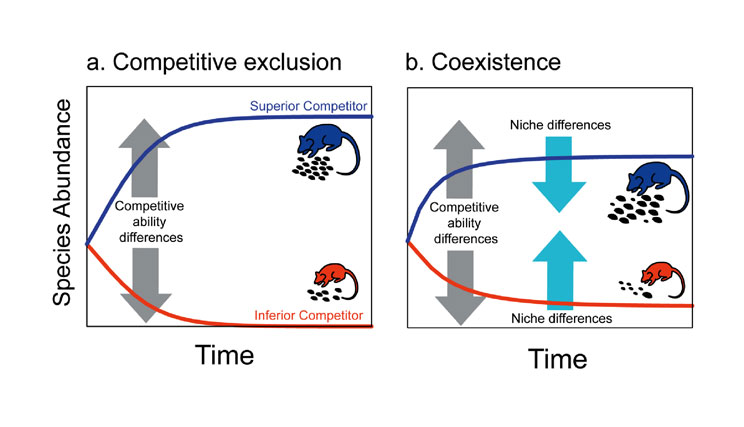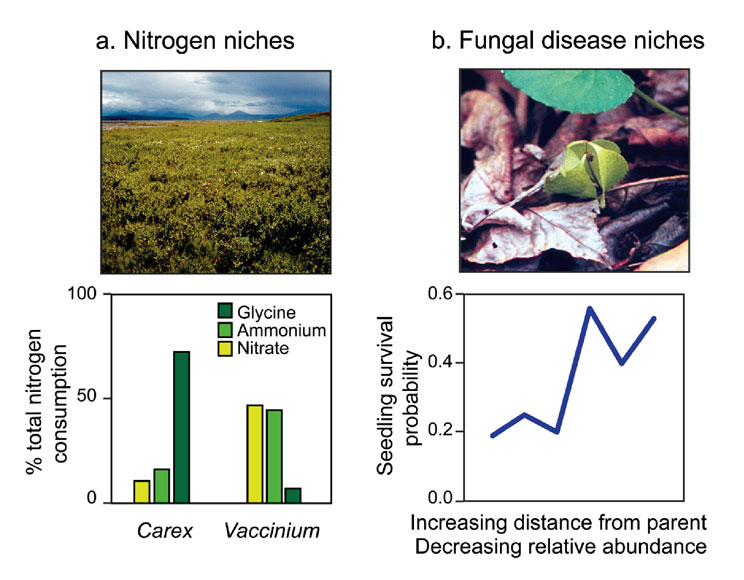« Prev Next »

The ecosystems of the world contain a remarkable diversity of species. An area of tropical rainforest the size of fifteen city blocks may contain over a thousand different tree species (Figure 1a, Kraft et al. 2008). As ecologists have found in a Panamanian rainforest, close examination of just one of these tree species can yield as many as 945 different species of beetles alone (Figure 1b, Erwin et al. 1980). This astonishing diversity also extends to aquatic environments. Africa’s Lake Malawi is home to over 500 species of fish belonging to a single genus (Figure 1c; Kornfield & Smith 2000). In fact, the number of species on Earth is so overwhelming that the 1.7 to 2 million species currently described by biologists (Millenium Ecosystem Assessment 2005) is likely to be only a small fraction of the true total.

Humankind derives tremendous benefits from the wide diversity of species on Earth, but this diversity also poses a fundamental ecological puzzle. Speciation, the evolutionary process by which new species are formed, is clearly responsible for the ultimate generation of species diversity over geologic time. But once generated, how is this diversity maintained? What prevents the single best competitor from displacing all other species? How different species coexist (co-occur in the same location for many generations) is a long-standing and not fully resolved question for ecologists (Gause 1934, Hutchinson 1961).
The mystery of species coexistence is rooted in the competitive exclusion principle, which states that two species competing for the same resource cannot coexist (Gause 1934, Hutchinson 1961). The species that is better at gaining the limiting resource will eventually eliminate the inferior competitor. This intuitive idea has been central to the field of ecology at least since Darwin’s exposition of his theory of evolution, but mathematical theory and laboratory experiments with single-celled organisms in the early part of the twentieth century reinforced this foundation (Gause 1934).
The simple prediction of the competitive exclusion principle is schematically portrayed in Figure 2a. If a superior and an inferior competitor are placed into a habitat at initially equal abundance, the former will inevitably eliminate the latter. Envision, for example, two rodent species, one that has a much greater ability than the other to consume seeds, the food resource limiting their growth. Eventually, the better seed competitor will win (the blue species in Figure 2a). The take home message is that differences in the competitive ability of different species cause their abundances to diverge over time, resulting in one species becoming more common while the other becomes less common (Gause 1934, Chesson 2000). If the differences in the competitive ability of species are large, the poorer competitor will be rapidly excluded. If these differences are small, exclusion will be slow.

The central prediction of the competitive exclusion principle, the elimination of all but the best competitor, lies in sharp contrast with what we see in nature; the coexistence of numerous species (Figure 1). This contrast poses an enigma. Ecologists resolve this enigma by reasoning that other species properties must prevent the elimination of the inferior competitors. These are what ecologists call niche differences, species differences that maintain diversity by preventing competitive exclusion (Figure 2b; Chesson 2000, Adler et al. 2007).
The niche is an abstract and often debated concept, but simply put, it defines how a species interacts with its environment (Chase & Liebold 2003). For example, the niches of the two rodent species in Figure 2b include their diet; the quantity and size of seeds consumed. A niche difference between species arises, for example, when one rodent (the blue) tends to consume larger seeds than the other (the orange) (Figure 2b). But how do such niche differences maintain species diversity?
Envision a scenario in which the rodent eating large seeds (the blue) becomes so common that its competitor becomes rare. This shift in rodent abundance will cause a deficit of large seeds and an abundance of small seeds in the habitat. Such a shift will benefit the small seed consuming species (in orange), at the expense of its competitor (in blue). Conversely, if the small seed consuming species becomes common, large seeds would be in abundance, allowing the large seed competitor to recover. Thus, the defining feature of a niche difference is that it causes each species to limit individuals of its own species more than it limits individuals of its competitor (Chesson 2000, Adler et al. 2007). Niche differences thereby disfavor species that become common and advantage those that are rare, which hinders competitive exclusion and maintains biodiversity (Figure 2b).
With competitive ability differences driving assemblages of species toward dominance by a single competitor, and niche differences opposing competitive exclusion by favoring species that drop to low abundance (Figure 2b), the outcome of competition (exclusion or coexistence) depends on the balance between the two types of species’ differences (Chesson 2000, Adler et al. 2007). If the stabilizing effects of niche differences are stronger than the differences in competitive ability, species will coexist and diversity will be maintained. By contrast, if differences in competitive ability are great, competitive exclusion will occur even with modest niche differences. In our example, this would occur if the rodents differed only slightly in the sizes of seeds consumed, but one species ate far more seeds than the other.
An analogy to the more familiar case of competing businesses reinforces the way ecologists think about species coexistence. Two airlines sharing the same routes are not likely to both stay in business (i.e., coexist) if passengers consistently value one airline over the other (a competitive ability difference). Nevertheless, the less competitive airline can still persist by offering different routes than its superior counterpart, thereby capitalizing on a different customer base (a niche difference). Of course, for coexistence, the offered routes must be sufficiently different, which in ecological language would be expressed as the need for the niche difference to outweigh the difference in competitive ability.
The niche differences studied by ecologists today can be more complex than the example in Figure 2b, but they all share the defining features of our hypothetical example. Figure 3 presents two results from the recent ecological literature. Scientists have shown that coexisting plant species in the arctic use different forms of nitrogen (Figure 3a; McKane et al. 2002). Such differences can stabilize plant coexistence by disfavoring species that become so abundant that their preferred form of nitrogen becomes less available.

Other niche differences involve consumers and disease. For example, when species are attacked by a specialist pathogen, a disease that harms only them, individuals are only “contagious” to others of the same species. This causes individuals of the diseased species to limit other individuals of their own species more than they limit their competitors. As is true for resource-based niche differences (Figures 2b and 3a), disease niches can thereby cause species to gain advantages when rare (when disease prevalence is low), and disadvantages when common (when disease prevalence is high). For example, seedlings of Pin Cherry, a North American tree, are more likely to escape fungal disease when rare, and not surrounded by other infected Pin Cherry individuals (Figure 3b; Packer & Clay 2000).
Other important niche differences arise when species grow best different habitats, such as shallow or deep soils for plants, or in different types of years (wet years versus dry years) (Chesson 2000). As long as these and other niche differences sufficiently benefit species that fall to low abundance in their habitat, diversity is maintained.
Although ecologists have a firm handle on the need for niche differences to maintain species diversity, many unresolved questions remain. For example, are there really hundreds of niche differences between species explaining the wide diversity found in tropical forests? Identifying the niche differences operating in specific habitats, and hyper diverse ecological systems (Figure 1) in particular, has proven challenging (Adler et al. 2007, Levine & HilleRisLambers 2009). This is because niche differences can arise through a wide variety of ecological interactions (Figure 3), and may operate over long time scales that are difficult to study. As a consequence, ecologists have yet to determine which niche differences are most important for the maintenance of diversity, and whether the identity of those niches changes with the habitat or organisms studied.
Ecologists also know little about how strongly niche differences stabilize coexistence in natural communities (Levine & HilleRisLambers 2009). Although the competitive exclusion principle states that two species competing for the same resource cannot coexist indefinitely (hence the importance of niches), evenly matched competitors can co-occur for long periods of time without any niche differences. This is the foundation of the recently proposed neutral theory (Hubbell 2001), which suggests that a competitive stalemate might be the best explanation for the diversity of species seen in nature. While ecologists generally agree that species are unlikely to be perfectly matched competitors, the influence of competitive ability differences and niche differences on coexistence remains difficult to quantify in natural habitats (Levine & HilleRisLambers 2009).
How species diversity is maintained may seem an abstract question, of interest only to ecologists. However, the dramatic impacts of humans on the environment, which include increasing global temperatures, the removal of top predators, or the addition of nitrogen (from the use of fertilizers) to habitats, can strongly alter the relative competitive ability and niche differences between co-occurring species. For example, nitrogen deposition can favor weedy species over slow growing competitors by minimizing the importance of competitive ability for nitrogen. The introduction of non-native species into new habitats may allow them to "escape" their natural enemies and become overwhelmingly abundant at the cost of native diversity. A better understanding of the mechanisms that contribute to species diversity will allow ecologists and conservation biologists to better predict and manage future biodiversity.
References and Recommended Reading
Adler, P. B., Hille Ris Lambers, J., & Levine, J. M. A niche for neutrality. Ecology Letters 10, 95–104 (2007).
Chase, J. M. & Leibold, M. A. Ecological Niches: linking classical and contemporary approaches. London, UK: The University of Chicago Press, 2003.
Chesson, P. Mechanisms of maintenance of species diversity. Annual Review of Ecology and Systematics 31, 343–366 (2000).
Erwin, T. L. & Scott, J. C. Seasonal and Size Patterns, Trophic Structure, and Richness of Coleoptera in the Tropical Arboreal Ecosystem: The Fauna of the Tree Luehea seemannii Triana and Planch in the Canal Zone of Panama. The Coleopterists Bulletin 34, 305–322 (1980).
Gause, G. F. The struggle for existence. New York, NY: Hafner Publishing Company, 1934.
Hubbell, S. P. The unified neutral theory of biodiversity and biogeography. Princeton, NJ: Princeton University Press, 2001.
Hutchinson, G. E. The paradox of the plankton. The American Naturalist 95, 137–145 (1961).
Kornfield I. & Smith, P. F. African cichlid fishes: model systems for evolutionary biology. Annual Review of Ecology and Systematics 31, 163–196 (2000).
Kraft, N. J. B., Valencia, R., & Ackerly, D. D. Functional traits and niche-based tree community assembly in an Amazonian forest. Science 322, 580–582 (2008).
Levine, J. M. & HilleRisLambers, J. The importance of niches for the maintenance of species diversity. Nature 461, 254–257 (2009).
McKane, R. B. et al. Resource-based niches provide a basis for plant species diversity and dominance in arctic tundra. Nature 415, 68–71 (2002).
Millennium Ecosystem Assessment (2005).
Packer, A. & Clay, K. Soil pathogens and spatial patterns of seedling mortality in a temperature tree. Nature 404, 278–281 (2000).






























